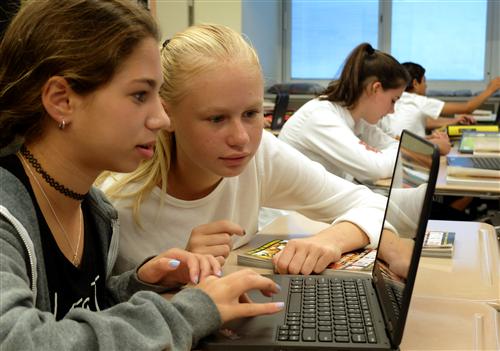
Livingston educators presented on Monday, Oct. 5 a vision for the future of technology in classrooms, including one-to-one computing, in which every student from Grades 7-12 would receive a laptop for Internet access and digital learning.
This was the district’s first formal presentation for the Livingston Board of Education on how 1:1 could change and transform teaching and learning in middle school and high school classrooms. It is the result of research over the past 18 months to create a vision and mission for technology, presented by co-chairs of the Technology Committee, Monica Cohen, educational technologist, and Jeffrey Wieboldt, a high school math teacher.
“It is critical that we keep our focus on learning, not on the technology,” Mrs. Cohen said, quoting from Jaime Casap, a global education evangelist for Goggle. “At the end of the day, the teacher is the single most important factor in a child’s education.”
With consensus from the Board of Education, teachers and community at large that the 1:1 initiative is educationally beneficial, the Tech Committee will now move forward on a whole host of considerations, including funding, network controls, and the type of device best suited for Livingston classrooms, said Interim Superintendent Dr. Ernest Palestis, who oversaw 1:1 when he served in a similar position for Ramapo and Indian Hills high schools during their launch of district-provided laptops to students.
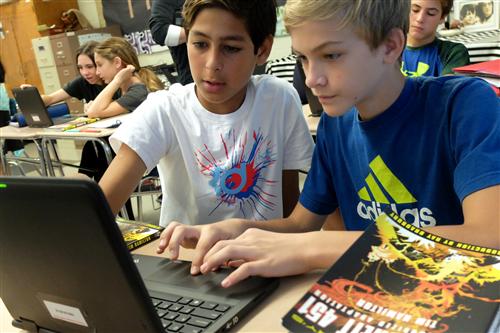
No decisions have yet been made beyond the recommendation that Livingston should move forward on 1:1 to provide the framework to teach 21st century skills in the 21st century context.
Teachers at Livingston High School and Heritage Middle School, responding to a tech survey last June, overwhelming indicated they would incorporate more tech ed into their lessons if they had the technology. “Over two-thirds of teachers at the high school said yes,” Mr. Wieboldt said. Similar results were recorded at Heritage.
“We need to work with students where they are,” said LHS Principal Mark Stern. “Our students are online, our students are involved in the tech age, so our schools have to be involved in the tech age."
Research-based standards and 14 critical elements outlined by the International Society for Technology in Education guided educators on the district tech committee, Mrs. Cohen said.
The work to date includes improving internet access and other upgrades to the network infrastructure to accommodate the 1:1 environment.
Livingston teachers have been engaged in professional development on learning and teaching in the digital age. The goal is to learn how best to use technology for collaborative work, for data collection and analysis, for sharing resources and files, organizing, and sharing ideas and information.

In addition, Livingston has two tech coaches working this year with teachers to connect curriculum with technology, Mrs. Cohen said.
It’s the type of learning observed in Laurie Bisconti’s social studies class at Heritage Middle School, where her eighth graders are engaged in lessons on finding fossils and artifacts. The classes are interactive with iPads, and Powerpoint, mobile smartboard, internet sources, music, and video. At their “dig conference,” the student paleontologists used all those so-called “arrows in the quiver” to share findings and make comparisons, physically and culturally, to unlock the mysteries of ancient life.
“Having technology in the classroom I think of as having another key tool in that teacher toolbox that is going to take everything you do to the next level,” said Mrs. Bisconti, whose lesson was one of four classes featured in a video presented as part of the push for 1:1.
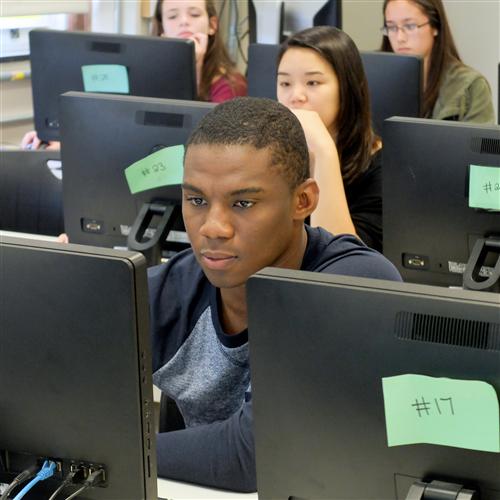
“People tend to be afraid that a 1:1 initiative and 21st century learning means that all students will be stuck like zombies behind a computer screen every day in class. But it’s actually the opposite of that,” explained Dakashna Lang, whose students were shown collaborating on online multimedia presentations on
Fahrenheit 451 by Ray Bradbury, the master of science fiction.
“What it really looks like is regular, engaging, stimulating teaching that we have all seen, except now with the ability to access resources at the touch of a button and to create in the classroom what previously could only be done at home," she said.
At the high school, the film by Jason Daily, a teacher of TV production at LHS, shows students creating an online notebook to share research on progressive presidents, and a marketing class with the tools to create business plans. “On the great benefits of the 1:1 initiative,” said Mr. Stern, the LHS principal, “is that even though we’re talking about technology, and it seems futurist and sci-fi, I actually think it makes learning more organic.” The vision statement … Technology opens pathways to explore, innovate, and collaborate to cultivate globally aware citizens” … led the Technology Committee to its mission … "Provide effective technology resources and training to foster a community of academic risk taking, innovation, collaboration, and global awareness."
The process also included visits by teams of Livingston educators to districts already providing computers to students. This included a high school with “Bring Your Own Device,” Mrs. Cohen pointed out, a plan rejected by that district after the first year for a variety of reasons, including the disparity of devices among students and the school system’s inability to filter the internet content on personal technology. Livingston educators gleaned several positive takeaways from visiting other schools last spring, Mrs. Cohen said, including how other New Jersey districts are using “real time” research, collaboration and discussion on both local and global levels, and how they use class time for guide practice using differentiated projects. In Livingston, according to the survey results presented by Mr. Wieboldt, 84 percent of high school students are accessing class information online on a daily/weekly basis; and monthly 60 percent are using the internet for research purposes and nearly half are using technology to collaborate with other students. At Heritage on a monthly basis, up to 50 percent of students are being exposed to participating in online projects, producing both teacher-centered and student-centered work, using the internet for research, and collaborating with other students, Mr. Wieboldt said. On the flip side, very few students ever collaborate with audiences globally, he said. 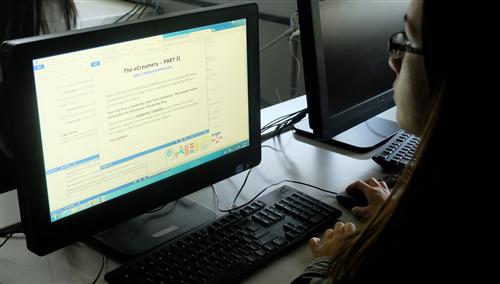 “We believe that the bottom half of the chart represents room for growth when students have technology available to them,” Mr. Wieboldt said. “Students having laptops will allow us to dramatically improve upon these results.” The Heritage English teacher, Mrs. Lang, is working on an advanced degree, doctor of education in literacy with a certificate in educational technology at Rutgers University. “My research addresses the question of whether or not using multimedia digital literacies in the classroom actually impacts student learning,” she said. The findings so far have been interesting. The data seems to show that students who struggle traditionally with reading and writing tasks benefit largely from using technology because it provides support and help in some areas that enables them to get their ideas out, whereas their great thinking may otherwise be squashed or hampered by the inability to write, or understand how to research, or perform a live presentation. “They have a schema for learning through technology because that's what they do at home,” Mrs. Lang said. On the other end of the spectrum, students who are usually highly successful with traditional reading and writing tasks also thrive from using technology because it opens up the possibilities of creativity and individuality.
“We believe that the bottom half of the chart represents room for growth when students have technology available to them,” Mr. Wieboldt said. “Students having laptops will allow us to dramatically improve upon these results.” The Heritage English teacher, Mrs. Lang, is working on an advanced degree, doctor of education in literacy with a certificate in educational technology at Rutgers University. “My research addresses the question of whether or not using multimedia digital literacies in the classroom actually impacts student learning,” she said. The findings so far have been interesting. The data seems to show that students who struggle traditionally with reading and writing tasks benefit largely from using technology because it provides support and help in some areas that enables them to get their ideas out, whereas their great thinking may otherwise be squashed or hampered by the inability to write, or understand how to research, or perform a live presentation. “They have a schema for learning through technology because that's what they do at home,” Mrs. Lang said. On the other end of the spectrum, students who are usually highly successful with traditional reading and writing tasks also thrive from using technology because it opens up the possibilities of creativity and individuality. 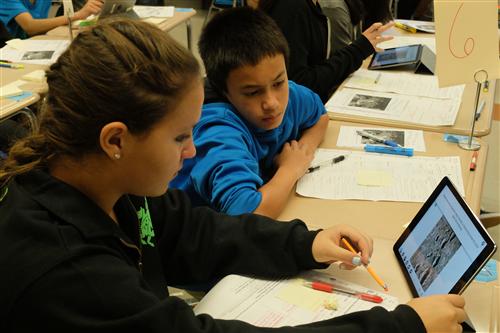 “They are not just accessing the same information from the same in class resources as everyone else. They are not just giving the same boring right answer,” Mrs. Lang said. “There are endless answers, endless data, and endless ways of presenting their information that shows more about who they are, beyond the right answers.” Learning becomes a transformative experience because students have tools that prompt inquiry-based lessons, teaching on the spot, and addressing the multiple needs on a variety of levels, said Patricia Boland, Assistant Superintendent of Curriculum and Instruction. “Having devices in the hands of all students enhances learning, prompts creativity, and increases interactive learning.” The next step is to have a financial package and recommendation for the type of laptop ready for review and discussion on the Monday, Nov. 23 meeting of the Board of Education.
“They are not just accessing the same information from the same in class resources as everyone else. They are not just giving the same boring right answer,” Mrs. Lang said. “There are endless answers, endless data, and endless ways of presenting their information that shows more about who they are, beyond the right answers.” Learning becomes a transformative experience because students have tools that prompt inquiry-based lessons, teaching on the spot, and addressing the multiple needs on a variety of levels, said Patricia Boland, Assistant Superintendent of Curriculum and Instruction. “Having devices in the hands of all students enhances learning, prompts creativity, and increases interactive learning.” The next step is to have a financial package and recommendation for the type of laptop ready for review and discussion on the Monday, Nov. 23 meeting of the Board of Education.
Article by Marilyn Joyce Lehren
No decisions have yet been made beyond the recommendation that Livingston should move forward on 1:1 to provide the framework to teach 21st century skills in the 21st century context.
In addition, Livingston has two tech coaches working this year with teachers to connect curriculum with technology, Mrs. Cohen said.
It’s the type of learning observed in Laurie Bisconti’s social studies class at Heritage Middle School, where her eighth graders are engaged in lessons on finding fossils and artifacts. The classes are interactive with iPads, and Powerpoint, mobile smartboard, internet sources, music, and video. At their “dig conference,” the student paleontologists used all those so-called “arrows in the quiver” to share findings and make comparisons, physically and culturally, to unlock the mysteries of ancient life.“People tend to be afraid that a 1:1 initiative and 21st century learning means that all students will be stuck like zombies behind a computer screen every day in class. But it’s actually the opposite of that,” explained Dakashna Lang, whose students were shown collaborating on online multimedia presentations on Fahrenheit 451 by Ray Bradbury, the master of science fiction.
“What it really looks like is regular, engaging, stimulating teaching that we have all seen, except now with the ability to access resources at the touch of a button and to create in the classroom what previously could only be done at home," she said.At the high school, the film by Jason Daily, a teacher of TV production at LHS, shows students creating an online notebook to share research on progressive presidents, and a marketing class with the tools to create business plans.“We believe that the bottom half of the chart represents room for growth when students have technology available to them,” Mr. Wieboldt said. “Students having laptops will allow us to dramatically improve upon these results.”
“They are not just accessing the same information from the same in class resources as everyone else. They are not just giving the same boring right answer,” Mrs. Lang said. “There are endless answers, endless data, and endless ways of presenting their information that shows more about who they are, beyond the right answers.”

